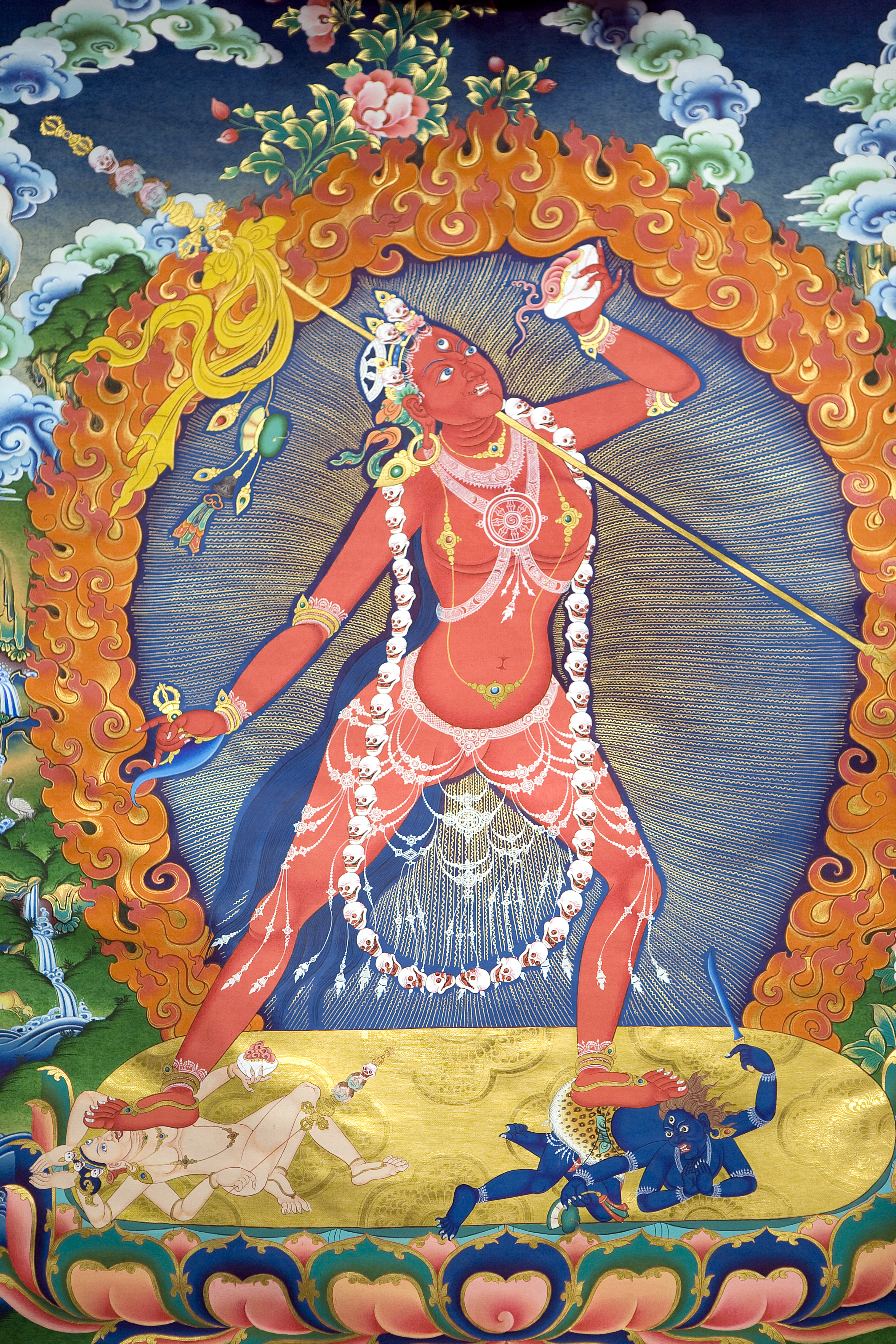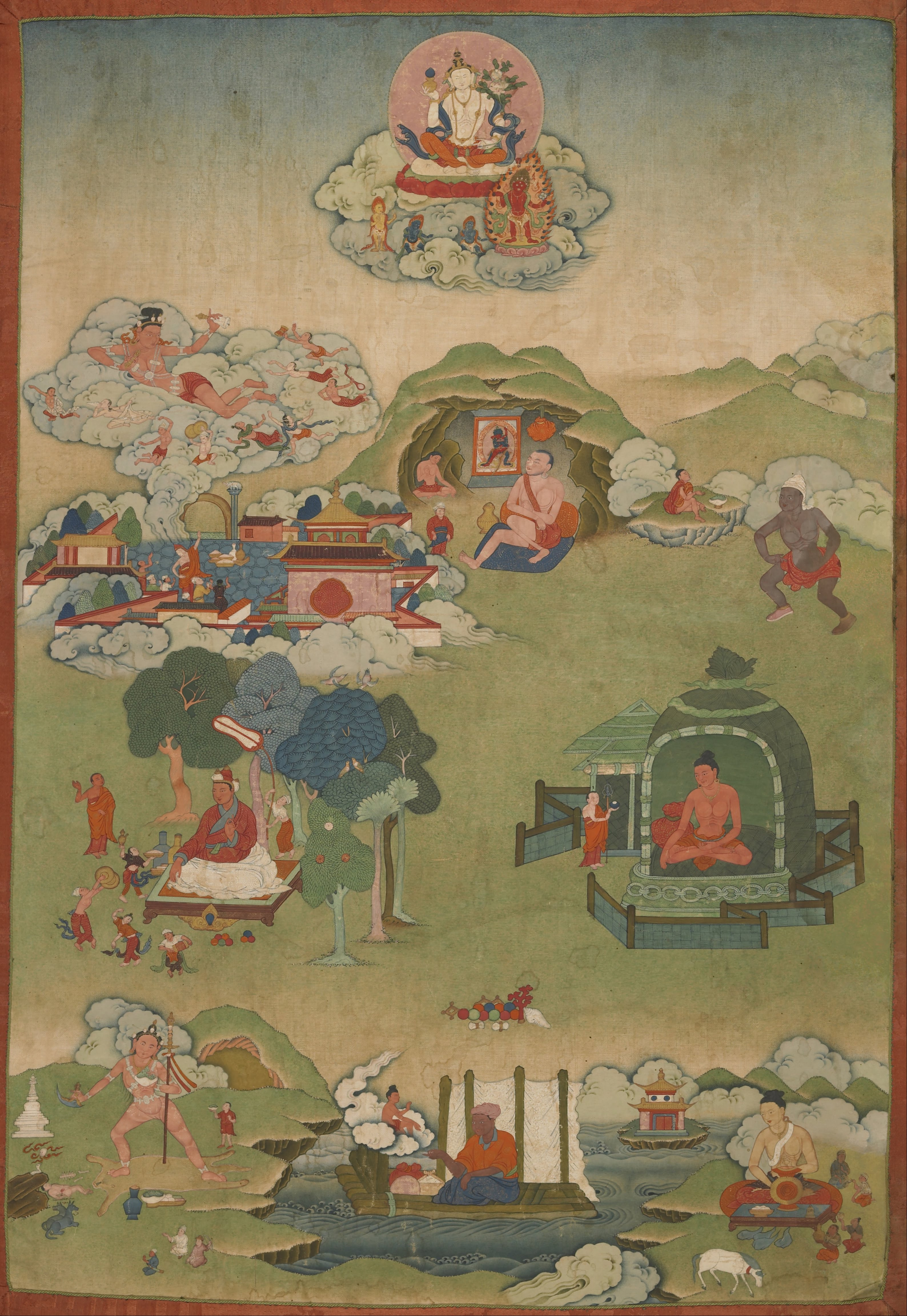|
Chinnamasta
Chhinnamasta ( sa, छिन्नमस्ता, , "She whose head is severed"), often spelled Chinnamasta, and also called Ch(h)innamastika and Prachanda Chandika and Jogani Maa (in western states of India), is a Hindu goddess (Devi). She is one of the Mahavidyas, ten goddesses from the esoteric tradition of Tantra, and a ferocious aspect of Mahadevi, the Hindu Mother goddess. The self-decapitated nude goddess, usually standing or seated on a divine copulating couple, holds her own severed head in one hand and a scimitar in another. Three jets of blood spurt out of her bleeding neck and are drunk by her severed head and two attendants. Chhinnamasta is a goddess of contradictions. She symbolises both aspects of Devi: a life-giver and a life-taker. She is considered both a symbol of sexual self-control and an embodiment of sexual energy, depending upon interpretation. She represents death, temporality, and destruction as well as life, immortality, and recreation. The godde ... [...More Info...] [...Related Items...] OR: [Wikipedia] [Google] [Baidu] |
Vajrayogini
Vajrayoginī ( sa, italic=yes, Vajrayoginī वज्रयोगिनी; , Dorjé Neljorma; mn, Огторгуйд Одогч, Нархажид, ) is a Tantric Buddhist female Buddha and a . The ''Vajrayogini'' cult dates back to the tenth and twelfth centuries. Vajrayoginī's essence is "great passion" (''maharaga''), a transcendent passion that is free of selfishness and illusion—she intensely works for the well-being of others and for the destruction of ego clinging. She is seen as being ideally suited for people with strong passions, providing the way to transform those passions into enlightened virtues. She is an Anuttarayoga Tantra iṣṭadevatā (meditation deity) and her practice includes methods for preventing ordinary death, intermediate state (bardo) and rebirth ( samsara) by transforming them into paths to enlightenment, and for transforming all mundane daily experiences into higher spiritual paths. Practices associated with her are Chöd and the Six Yogas of ... [...More Info...] [...Related Items...] OR: [Wikipedia] [Google] [Baidu] |
Mahavidya
The ''Mahavidya'' ( sa, महाविद्या, , lit. ''Great Wisdoms'') are a group of ten Hinduism, Hindu Tantra, Tantric Devi, goddesses. The 10 Mahavidyas are usually named in the following sequence: Kali, Tara (Devi), Tara, Tripura Sundari, Bhuvaneshvari, Bhairavi , Chhinnamasta, Dhumavati, Bagalamukhi, Matangi and Kamalatmika, Kamala. Nevertheless the formation of this group encompass divergent and varied religious traditions that include ''yogini'' worship, Saivism, Vaishnavism, and Vajrayana Buddhism. The development of the Mahavidyas represent an important turning point in the history of Shaktism as it marks the rise of the Bhakti aspect in Shaktism, which reached its zenith in 1700 CE. First sprung forth in the post-Puranic age, around 6th century C.E., it was a new theistic movement in which the supreme being was envisioned as female. A fact epitomized by texts like ''Devi-Bhagavata Purana'', especially its last nine chapters (31-40) of the seventh ''skandha'', ... [...More Info...] [...Related Items...] OR: [Wikipedia] [Google] [Baidu] |
Parvati
Parvati ( sa, पार्वती, ), Uma ( sa, उमा, ) or Gauri ( sa, गौरी, ) is the Hindu goddess of power, energy, nourishment, harmony, love, beauty, devotion, and motherhood. She is a physical representation of Mahadevi in her complete form. She is also revered in her appearances as Durga and Kali.Suresh Chandra (1998), Encyclopedia of Hindu Gods and Goddesses, , pp 245–246 She is one of the central deities of the goddess-oriented sect called Shaktism, and the chief goddess in Shaivism. Along with Lakshmi and Saraswati, she forms the Tridevi. Parvati is the wife of the Hindu god Shiva. She is the reincarnation of Sati, the first wife of Shiva who immolated herself during a yajna (fire-sacrifice).Edward Balfour, , The Encyclopaedia of India and of Eastern and Southern Asia, pp 153 Parvati is the daughter of the mountain-king Himavan and queen Mena.H.V. Dehejia, Parvati: Goddess of Love, Mapin, , pp 11 Parvati is the mother of the Hindu deities Ganesha and ... [...More Info...] [...Related Items...] OR: [Wikipedia] [Google] [Baidu] |
Blood Squirt
Blood squirt (blood spurt, blood spray, blood gush, or blood jet) is the effect when an artery is ruptured. Blood pressure causes the blood to bleed out at a rapid, intermittent rate in a spray or jet, coinciding with the pulse, rather than the slower, but steady flow of venous bleeding. Also known as arterial bleeding, arterial spurting, or arterial gushing, the amount of blood loss can be copious, occur very rapidly, and can led to death by a process called exsanguination. Anatomy In cut carotid arteries with 100 mL of blood through the heart at each beat (at 65 beats a minute), a completely severed artery will spurt blood for about 30 seconds and the blood will not spurt much higher than the human head. If the artery is just nicked, on the other hand, the blood will spurt longer but will be coming out under pressure and spraying much farther. To prevent hand ischemia, there is a "squirt test" that involves squirting blood from the radial artery, which is used in intraoperativ ... [...More Info...] [...Related Items...] OR: [Wikipedia] [Google] [Baidu] |
Mahavidyas
The ''Mahavidya'' ( sa, महाविद्या, , lit. ''Great Wisdoms'') are a group of ten Hinduism, Hindu Tantra, Tantric Devi, goddesses. The 10 Mahavidyas are usually named in the following sequence: Kali, Tara (Devi), Tara, Tripura Sundari, Bhuvaneshvari, Bhairavi , Chhinnamasta, Dhumavati, Bagalamukhi, Matangi and Kamalatmika, Kamala. Nevertheless the formation of this group encompass divergent and varied religious traditions that include ''yogini'' worship, Saivism, Vaishnavism, and Vajrayana Buddhism. The development of the Mahavidyas represent an important turning point in the history of Shaktism as it marks the rise of the Bhakti aspect in Shaktism, which reached its zenith in 1700 CE. First sprung forth in the post-Puranic age, around 6th century C.E., it was a new theistic movement in which the supreme being was envisioned as female. A fact epitomized by texts like ''Devi-Bhagavata Purana'', especially its last nine chapters (31-40) of the seventh ''skandha'', ... [...More Info...] [...Related Items...] OR: [Wikipedia] [Google] [Baidu] |
Mekhala And Kanakhala
Mekhala ( or Mahakhala – "Elder Mischievous Girl") "The Elder Severed-Headed Sister" and Kanakhala (Kankhala, – "Younger Mischievous Girl") "The Younger Severed-Headed Sister") are two sisters who figure in the eighty-four mahasiddhas ("great adept") of Vajrayana Buddhism. Both are described as the disciples of another mahasiddha, Kanhapa (Krishnacharya). They are said to have severed their heads and offered them to their guru, and then danced headless. Their legend is closely associated with the Buddhist severed-headed goddess Chinnamunda. Legend ''The Legends of the Eighty-four Mahasiddhas'' (, written by the Tibetan monk Mondup Sherab, which was narrated to him by Abhayadattashri c. 12th century) narrates the following tale: Mekhala and Kanakhala were daughters of a householder in Devīkoṭṭa (now in Bengal), who married them to sons of a boatman. Their husbands taunted them and their neighbours gossiped about them. Finally, Kanakhala could not take the abuse any mor ... [...More Info...] [...Related Items...] OR: [Wikipedia] [Google] [Baidu] |
Kanhapa
Kānhapā, Kanha or Kanhapada or Krishnacharya ( c 10th century AD) was one of the main poets of ''Charyapada'', the earliest known example of Assamese, Bengali, Maithili and Odia literature. He was a tantric Buddhist and a disciplle of Jalandhar. Kanhapada is also a prominent siddhacharya to Nath Sampradaya after Matsyendranatha and Gorakhnath Gorakhnath (also known as Goraksanath, c. early 11th century) was a Hindu yogi, saint who was the influential founder of the Nath Hindu monastic movement in India He is considered one of the two notable disciples of Matsyendranath. His follower .... His poems in Charjyapad are written in a code, whereby every poem has a descriptive or narrative surface meaning but also encodes tantric Buddhist teachings. Some experts believe this was to conceal sacred knowledge from the uninitiated, while others hold that it was to avoid religious persecution. In one of his poems, Kanhupa wrote: The language of Kanhupa's poetry bears a very stro ... [...More Info...] [...Related Items...] OR: [Wikipedia] [Google] [Baidu] |
Vajrayana
Vajrayāna ( sa, वज्रयान, "thunderbolt vehicle", "diamond vehicle", or "indestructible vehicle"), along with Mantrayāna, Guhyamantrayāna, Tantrayāna, Secret Mantra, Tantric Buddhism, and Esoteric Buddhism, are names referring to Buddhism, Buddhist traditions associated with Tantra and "Secret Mantra", which developed in the Medieval India, medieval Indian subcontinent and spread to Tibet, Nepal, other Himalayan states, East Asia, and Mongolia. Vajrayāna practices are connected to specific lineages in Buddhism, through the teachings of lineage holders. Others might generally refer to texts as the Buddhist Tantras. It includes practices that make use of mantras, dharanis, mudras, mandalas and the visualization of deities and Buddhas. Traditional Vajrayāna sources say that the tantras and the lineage of Vajrayāna were taught by Gautama Buddha, Śākyamuni Buddha and other figures such as the bodhisattva Vajrapani and Padmasambhava. Contemporary historians of Bu ... [...More Info...] [...Related Items...] OR: [Wikipedia] [Google] [Baidu] |
Tibetan Buddhism
Tibetan Buddhism (also referred to as Indo-Tibetan Buddhism, Lamaism, Lamaistic Buddhism, Himalayan Buddhism, and Northern Buddhism) is the form of Buddhism practiced in Tibet and Bhutan, where it is the dominant religion. It is also in majority regions surrounding the Himalayan areas of India (such as Ladakh, Sikkim, Arunachal Pradesh, and a minority in Himachal Pradesh and Uttarakhand), in much of Central Asia, in the southern Siberian regions such as Tuva, and in Mongolia. Tibetan Buddhism evolved as a form of Mahāyāna Buddhism stemming from the latest stages of Indian Buddhism (which also included many Vajrayāna elements). It thus preserves many Indian Buddhist tantric practices of the post-Gupta early medieval period (500 to 1200 CE), along with numerous native Tibetan developments. In the pre-modern era, Tibetan Buddhism spread outside of Tibet primarily due to the influence of the Mongol Yuan dynasty (1271–1368), founded by Kublai Khan, which had ruled China, ... [...More Info...] [...Related Items...] OR: [Wikipedia] [Google] [Baidu] |
Mahadevi
Mahadevi ( sa, महादेवी, ), also referred to as Adi Parashakti, Adi Shakti, and Abhaya Shakti, is the supreme goddess in the Shaktism sect of Hinduism. According to this tradition, all Hindu goddesses are considered to be manifestations of this single great Goddess, who is comparable to the deities Vishnu and Shiva as Para Brahman. Vaishnavas consider her to be Lakshmi, Shaivas consider her to be Parvati, Durga, and Mahakali, while Shaktas consider her to be Durga, Tripura Sundari, Bhuvaneswari, and Kali. Author Helen T. Boursier says: "In Hindu philosophy, both Lakshmi and Parvati are identified with the great goddess Mahadevi and the Shakti or divine power". Vaishnavism The goddess Lakshmi is revered as Mahadevi in the Vaishnavite tradition, extolled to possess a thousand names and qualities such as The Bestower of Prosperity, The Lotus-eyed One, The Omniscient One, The One Who Meditates On The Ultimate Reality, as well as The One With The Cosmic Form. Var ... [...More Info...] [...Related Items...] OR: [Wikipedia] [Google] [Baidu] |
Mahasiddha
Mahasiddha (Sanskrit: ''mahāsiddha'' "great adept; ) is a term for someone who embodies and cultivates the " siddhi of perfection". A siddha is an individual who, through the practice of sādhanā, attains the realization of siddhis, psychic and spiritual abilities and powers. Mahasiddhas were practitioners of yoga and tantra, or ''tantrika''s. Their historical influence throughout the Indian subcontinent and the Himalayas was vast and they reached mythic proportions as codified in their songs of realization and hagiographies, or namtars, many of which have been preserved in the Tibetan Buddhist canon. The Mahasiddhas are the founders of Vajrayana traditions and lineages such as Dzogchen and Mahamudra. Robert Thurman explains the symbiotic relationship between Tantric Buddhist communities and the Buddhist universities such as Nalanda which flourished at the same time. Genealogy and historical dates The exact genealogy and historical dates of the Mahasiddhas are contentiou ... [...More Info...] [...Related Items...] OR: [Wikipedia] [Google] [Baidu] |





_(8697431158).jpg)
.jpeg/1200px-Tibetan_Buddhism_(214837929).jpeg)

